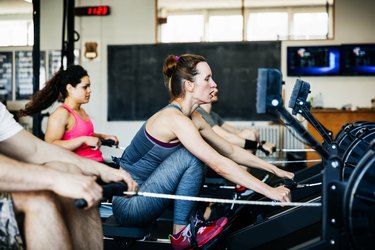
Uterus pain after exercising can be difficult to pinpoint. It will typically manifest in the lower abdomen since this organ is part of your reproduction system. If you regularly experience lower abdomen pain after exercising, consult with your doctor for a proper diagnosis and treatment.
Read more: Running and Severe Upper Abdominal Pain
Video of the Day
Video of the Day
Lower Abdominal Pain After Exercise
If you're experiencing pain because of your menstrual cycle, your cramps may begin a few days before your period and become more severe once your period begins. Increased blood flow to your organs can cause increased period pain after exercise. If you have severe cramping from a menstrual period, exercise can seem almost impossible. Endometriosis can cause pain in your uterus a few weeks before your period starts. After physical activity and sex, the pain may be most noticeable.
If you have an allergic reaction to exercise, cramping of the uterus is one of the many symptoms and can occur during or after exercising, according to the American Academy of Allergy Asthma & Immunology. Pelvic Inflammatory Disease, or PID can also cause lower abdominal pain after exercise that's sometimes accompanied with unusual discharge and possible pain urinating, according to the Centers for Disease Control and Prevention.
Pelvic Pain After Exercise: Causes
Your uterus contracts to remove cells and tissues from your body if fertilization has not occurred during the cycle, which results in your period. A hormone-like substance called prostaglandins is often responsible for pain and inflammation you experience with menstrual cramps. Endometriosis is caused by the lining of your uterus growing outside of the uterus, which results in painful scar tissue, according to the UCSF Medical Center.
Exercise-induced anaphylaxis is a result of your immune system overreacting to your body's response to exercise and releasing chemicals that cause an allergic reaction, but the cause for the reaction is unknown. PID is usually caused by a sexually transmitted disease, but can also be a result of douching or IUD birth control methods.
Read more: Causes of Abdominal Pain and Fatigue
Treatment for Pelvic Pain
If you're experiencing menstrual cramps after exercising, take an over-the-counter nonsteroidal anti-inflammatory and relax on a heating pad. You can also take anti-inflammatory medication to control the pain from endometriosis after exercising. In worse case scenarios, surgery or a hysterectomy will be needed, according to Mayo Clinic.
If you have symptoms that involve difficulties breathing, feeling dizzy, experiencing hives or have low blood pressure that accompany your uterus cramping after exercise, seek emergency medical care. You may need an injection of epinephrine and your doctor will often prescribe an auto-injectable epinephrine in case the problem reoccurs during or after exercising.
Considerations After Pregnancy
Pain in your uterus after exercising rarely indicates a medical problem. If you've recently had a baby, the tissues of your uterus may be overstretched or torn and the muscles surrounding your uterus may be weak. The muscles surrounding your uterus can have the same problems as muscles in other locations of your body, such as delayed onset muscle soreness after exercising, so continue to exercise unless you have been instructed to discontinue physical activity by your doctor. If you're pregnant, the pain you're experiencing could be from the round ligament stretching which supports your growing uterus.